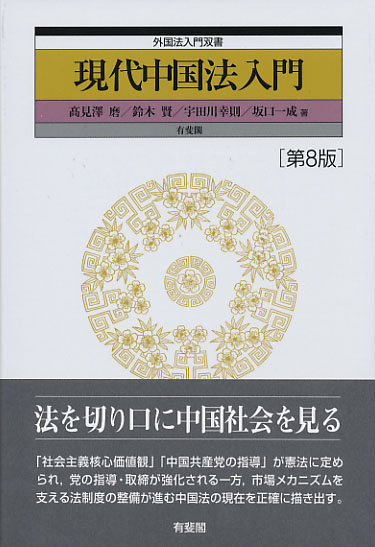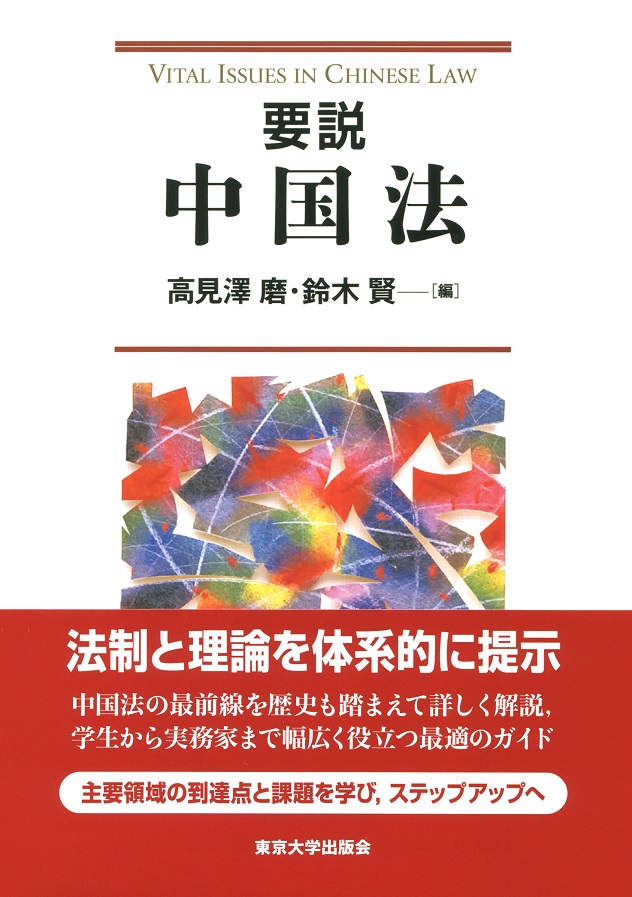
Title
Introduction to the Foreign Law Series Gendai Chugoku-ho Nyumon (Introduction to Contemporary Chinese Law - 8th Edition)
Size
470 pages, 127x188mm, hardcover
Language
Japanese
Released
December, 2019
ISBN
978-4-641-04825-6
Published by
Yuhikaku Publishing
Book Info
See Book Availability at Library
Japanese Page
As stated by the title, this book is an introductory text for beginning students of contemporary Chinese law (the law of the People’s Republic of China). The first edition was published in 1998; the text has since gone through eight editions, with the content updated approximately every three years. This eighth edition is the collaborative work of four authors who were each responsible for drafting particular chapters, after which all of the authors came together to finalize the text. This is not a collection of essays, but rather a text in which all chapters are the joint work of the four authors, with an emphasis on overall systematic organization (nonetheless, the authors who originally drafted the chapters have left their individual marks upon them, providing added enjoyment to readers). The fundamental purpose of the book is to offer readers material to consider the ways in which the law plays a functional role in China. To this end, the book stresses historical inquiry, and takes care to describe the connections between politics and society.
Chapter 1 examines indigenous (traditional Chinese) law prior to the institution of modern, Western-style law in the late Qing era, as well as the subsequent history of modern law in the late Qing and Republican periods, while Chapter 2 gives a historical overview of the law of the People’s Republic of China in relation to politics. These chapters also provide a foundation for thinking about present-day Taiwan, Hong Kong, and Macao from the perspective of law. After exploring the historical ties between Chinese law and society, we proceed to scrutinize various areas of law. With regard to Chapter 3 onward, please refer to the table of contents (below). Chapter 6 addresses corporate, company, commercial, and economic law. Chapter 7 delves into family, labor, and social security law, and Chapter 9 covers penal law and the Criminal Procedure Law, as well as administrative penalties.
Since the publication of this book in 2019, developments such as the 2020 enactment of the Civil Code and certain legislative actions in Hong Kong have taken place. It is in the nature of a printed publication that new editions must be printed to respond to events occurring after publication, but since the eighth edition, we have been providing supplements on the website of the publisher, Yuhikaku, enabling us to respond to some extent.
http://www.yuhikaku.co.jp/books/detail/9784641048256
This is a new initiative for the eighth edition. Please refer to it along with the book. Some readers may be surprised by the large number of errata. These are generally oversights by the authors, but by way of excuse, we can cite the vigorous legislative activities in modern China (including law amendment) as a background factor. Among these legislative activities, we can easily identify some that resemble the civil and commercial law and corporate activity-related law studied in Japanese law schools, offering a glimpse into China’s socioeconomic development as a market. This gives a sense of the law as a bundle of rights. Meanwhile, the leadership of the Chinese Communist Party is being strongly incorporated into law. We perceive it as a tool of governance, as well as an instrument for displaying good governance; we would like to convey this duality to the readers of this book.
(Written by TAKAMIZAWA Osamu, Professor, Institute for Advanced Studies on Asia / 2020)



 Find a book
Find a book


 eBook
eBook